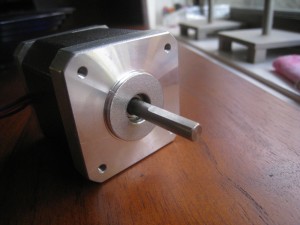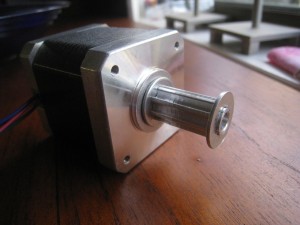Several people have recommended that having flats on your motor shafts is a good idea. After having a couple of issues with my extruder motor gear slipping, I thought that it might be a good idea, too. The suggested way of doing it is to grip your motor shaft in a vice, and then file it down.
Fortunately, at my workplace, there’s a guy who’s a keen machinist. I passed the stepper motors along to him, and asked him if he could put some flats on the shafts. He thought it was a pretty easy job, and didn’t even ask for payment in beer. Here’s the results back a few days later.
Now with some nice flats on the motor shafts, I thought that this would be a good time to fit the aluminium pulleys I had previously purchased. Unfortunately, the grub screws for these pulleys are far to long, they sit up into the tooth void when screwed down, causing the belt to skip over that tooth. To rectify this, I’d have to cut the screws down.
My first attempt was to cut the screw in half with a hacksaw. Unfortunately, this was a bit too much, and only left about 1mm of screw remaining. This should work in securing the pulley, but I’ll have to keep an eye on it.
For the second attempt, I just held the grub screw with a set of small pliers, and filed the end down to a shorter length. Although it was quite slow, it did the trick in getting the screw to just the right length.
Here’s the motor with the pulley attached. It looks great, and should really cut down on backlash. The belt fits in like glue.
